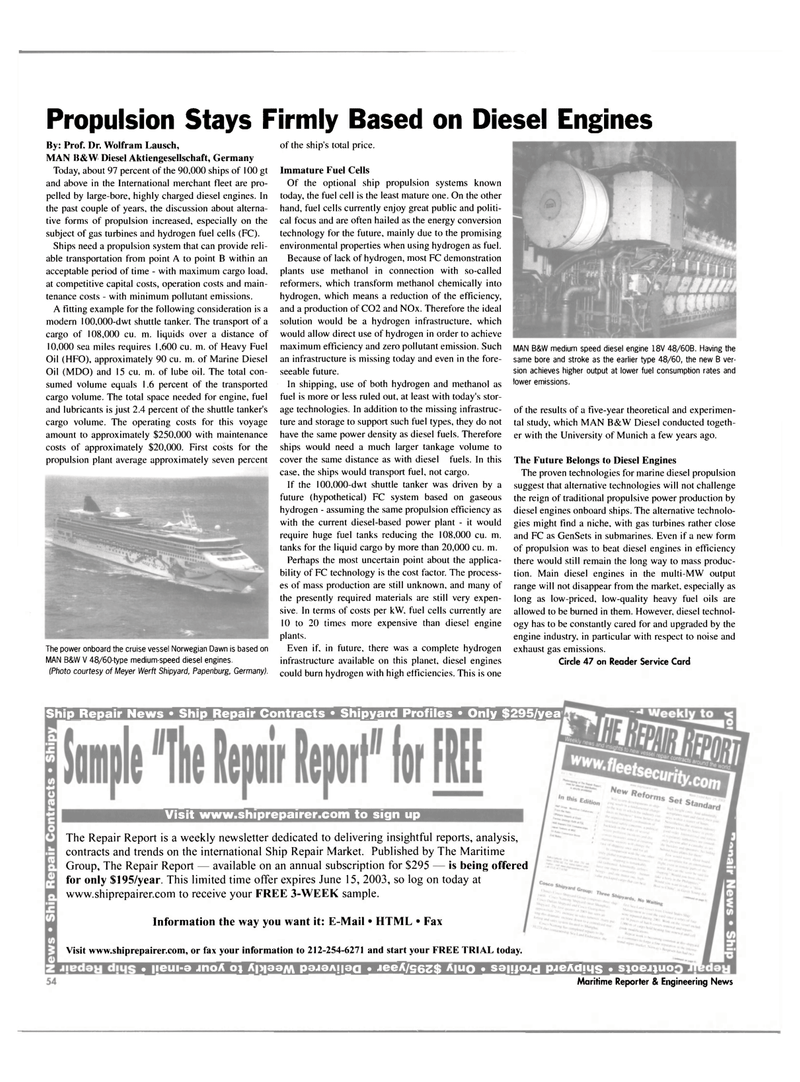
Page 54: of Maritime Reporter Magazine (May 2003)
Read this page in Pdf, Flash or Html5 edition of May 2003 Maritime Reporter Magazine
Propulsion Stays Firmly Based on Diesel Engines
By: Prof. Dr. Wolfram Lausch,
MAN 15&W Diesel Aktiengesellschaft, Germany
Today, about 97 percent of the 90,000 ships of 100 gt and above in the International merchant fleet are pro- pelled by large-bore, highly charged diesel engines. In the past couple of years, the discussion about alterna- tive forms of propulsion increased, especially on the subject of gas turbines and hydrogen fuel cells (FC).
Ships need a propulsion system that can provide reli- able transportation from point A to point B within an acceptable period of time - with maximum cargo load, at competitive capital costs, operation costs and main- tenance costs - with minimum pollutant emissions.
A fitting example for the following consideration is a modern 100,000-dwt shuttle tanker. The transport of a cargo of 108,000 cu. m. liquids over a distance of 10,000 sea miles requires 1,600 cu. m. of Heavy Fuel
Oil (HFO), approximately 90 cu. m. of Marine Diesel
Oil (MDO) and 15 cu. m. of lube oil. The total con- sumed volume equals 1.6 percent of the transported cargo volume. The total space needed for engine, fuel and lubricants is just 2.4 percent of the shuttle tanker's cargo volume. The operating costs for this voyage amount to approximately $250,000 with maintenance costs of approximately $20,000. First costs for the propulsion plant average approximately seven percent
The power onboard the cruise vessel Norwegian Dawn is based on
MAN B&W V 48/60-type medium-speed diesel engines. (Photo courtesy of Meyer Werft Shipyard, Papenburg, Germany). of the ship's total price.
Immature Fuel Cells
Of the optional ship propulsion systems known today, the fuel cell is the least mature one. On the other hand, fuel cells currently enjoy great public and politi- cal focus and are often hailed as the energy conversion technology for the future, mainly due to the promising environmental properties when using hydrogen as fuel.
Because of lack of hydrogen, most FC demonstration plants use methanol in connection with so-called reformers, which transform methanol chemically into hydrogen, which means a reduction of the efficiency, and a production of C02 and NOx. Therefore the ideal solution would be a hydrogen infrastructure, which would allow direct use of hydrogen in order to achieve maximum efficiency and zero pollutant emission. Such an infrastructure is missing today and even in the fore- seeable future.
In shipping, use of both hydrogen and methanol as fuel is more or less ruled out, at least with today's stor- age technologies. In addition to the missing infrastruc- ture and storage to support such fuel types, they do not have the same power density as diesel fuels. Therefore ships would need a much larger tankage volume to cover the same distance as with diesel fuels. In this case, the ships would transport fuel, not cargo.
If the 100,000-dwt shuttle tanker was driven by a future (hypothetical) FC system based on gaseous hydrogen - assuming the same propulsion efficiency as with the current diesel-based power plant - it would require huge fuel tanks reducing the 108,000 cu. m. tanks for the liquid cargo by more than 20,000 cu. m.
Perhaps the most uncertain point about the applica- bility of FC technology is the cost factor. The process- es of mass production are still unknown, and many of the presently required materials are still very expen- sive. In terms of costs per kW. fuel cells currently are 10 to 20 times more expensive than diesel engine plants.
Even if, in future, there was a complete hydrogen infrastructure available on this planet, diesel engines could burn hydrogen with high efficiencies. This is one
MAN B&W medium speed diesel engine 18V 48/60B. Having the same bore and stroke as the earlier type 48/60, the new B ver- sion achieves higher output at lower fuel consumption rates and lower emissions. of the results of a five-year theoretical and experimen- tal study, which MAN B&W Diesel conducted togeth- er with the University of Munich a few years ago.
The Future Belongs to Diesel Engines
The proven technologies for marine diesel propulsion suggest that alternative technologies will not challenge the reign of traditional propulsive power production by diesel engines onboard ships. The alternative technolo- gies might find a niche, with gas turbines rather close and FC as GenSets in submarines. Even if a new form of propulsion was to beat diesel engines in efficiency there would still remain the long way to mass produc- tion. Main diesel engines in the multi-MW output range will not disappear from the market, especially as long as low-priced, low-quality heavy fuel oils are allowed to be burned in them. However, diesel technol- ogy has to be constantly cared for and upgraded by the engine industry, in particular with respect to noise and exhaust gas emissions.
Circle 47 on Reader Service Card
Ship Repair News • Ship Repair Contracts • Shipyard Profiles • Only $295/yea
Visit www.shiprepairer.com to sign up
The Repair Report is a weekly newsletter dedicated to delivering insightful reports, analysis, contracts and trends on the international Ship Repair Market. Published by The Maritime
Group, The Repair Report — available on an annual subscription for $295 — is being offered for only $195/year. This limited time offer expires June 15, 2003, so log on today at www.shiprepairer.com to receive your FREE 3-WEEK sample.
Information the way you want it: E-Mail • HTML • Fax
Visit www.shiprepairer.com, or fax your information to 212-254-6271 and start your FREE TRIAL today. • |ieui-d jnoA 01 A|>|eajyy pejQAjieq . 4eeA/s6Z$ • sa|!|OJj pjeAdms • sioe.i|uo 48 Maritime Reporter & Engineering News

 53
53

 55
55
